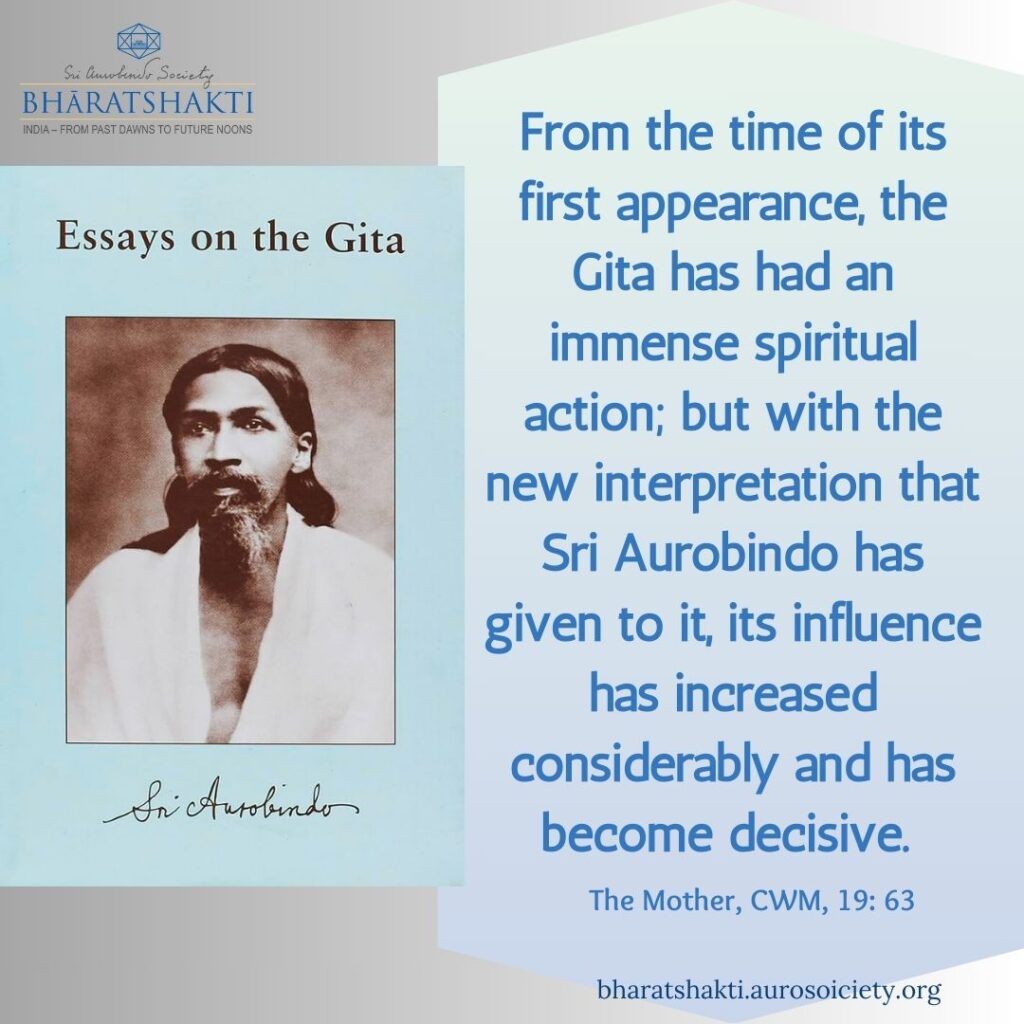Date: May 20, 2025
Part 5: Sānkhya Yoga – 2
Continued from Part 4
In the next several verses is expounded Gita’s teaching of the Buddhi-yoga, the Yoga of the Intelligent Will. This teaching builds upon two foundations: a) the Vedantic Sānkhya of the Upanishads and b) Yoga, a principally subjective practice and inner change which is necessary for the finding of the Self or the union with God. Sri Krishna assures Arjuna that even a little of this Yoga brings deliverance to the sincere aspirant.
“When you have once set out on this path, you will find that no step is lost; every least movement will be a gain; you will find there no obstacle that can baulk you of your advance.”
~ ibid., p. 95
For our own efforts and practice on the path of Buddhi-yoga, it is important to understand the large philosophic sense in which the Gita uses the word buddhi. Generally the word Buddhi implies the mental power of understanding. But the Gita uses it in a large philosophic sense and there it stands for “the whole action of the discriminating and deciding mind”. This action determines two things — the direction and use of our thoughts, and the direction and use of our acts. So we see that thought, intelligence, judgment, perceptive choice and aim are all included in the functioning of Buddhi.

Through Sri Krishna’s teaching of the Buddhi-yoga, the Gita stresses for us the necessity for cultivating a concentrated and unified intelligence. But this unified intelligence is not merely about cultivating concentration of the mind that knows. It is rather, and more importantly and essentially, about concentration of the mind that decides and persists in the decision. The term used in the Gita for such one-pointed concentration is vyavasāya.
On the other hand, the chief sign of a dissipated intelligence is discursiveness of the aims and desires, not so much the discursiveness of the ideas and perceptions. When we fail to have a concentration of our aims and desires, we fail to have a unified and concentrated will. This Will and Knowledge are two functions of the Buddhi, emphasises the Gita.
Sri Krishna then speaks of the spirit of equality with which all work must be done. This equality is not mere disinterestedness but a state of inner poise and wideness, and is the foundation of spiritual freedom. And in that freedom one must do the “work that is to be done,” a phrase, which Sri Aurobindo reminds us, is used by the Gita with the greatest wideness. The phrase includes in itself all works, and far exceeds, though it may include, social duties or ethical obligations. At the same time, “what is the work to be done is not to be determined by the individual choice.”
Sri Aurobindo makes an important point when he adds that the right to the action and the rejection of claim to the fruit are not the great word of the Gita. They are rather preliminary steps governing the first state of the disciple when he begins his ascent on the hill of Yoga.
The yogin who has united his reason and will with the Divine, even while present in this world of dualities, casts away from him both good doing and evil doing, “…for he rises to a higher law beyond good and evil, founded in the liberty of self-knowledge. …action done in Yoga is not only the highest but the wisest, the most potent and efficient even for the affairs of the world; for it is informed by the knowledge and will of the Master of works.” (ibid., p. 103).
When Arjuna demands to know some signs by which such a yogin may be recognised, Sri Krishna says that equality is the “great stamp of the liberated soul. He is “a man with mind untroubled by sorrows, who has done with desire for pleasures, from whom liking and wrath and fear have passed away, such is the sage whose understanding has become founded in stability.” Possessed of his self and ever-stationed in his true being, such a person is “without the triple action of the qualities of Prakriti, without the dualities.” (ibid., p. 102).
But the kind of self-control and control of the senses and mind that is demanded cannot be done perfectly by the act of the intelligence itself, by a merely mental self-discipline. It can only be done by uniting with something which is higher than itself and in which calm and self-mastery are inherent.
“And this Yoga can only arrive at its success by devoting, by consecrating, by giving up the whole self to the Divine…. the Liberator is within us, but it is not our mind, nor our intelligence, nor our personal will,…they are only instruments. It is the Lord in whom…we have utterly to take refuge. And for that we must at first make him the object of our whole being and keep in soul-contact with him.”
~ ibid., p. 101
In this way, in Chapter 2, the Gita subtly unifies Sānkhya, Yoga and Vedanta, and lays down the first foundation of its teaching. By teaching Arjuna, and through him, the entire humanity, Sri Krishna here speaks of the “first indispensable practical unity of knowledge and works with a hint already of the third crowning intensest element in the soul’s completeness, divine love and devotion.” (p. 104).
